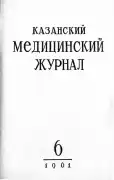Endemic goiter in the Volzhsk region
- Authors: Khakimova A.M.
- Issue: Vol 42, No 6 (1961)
- Pages: 70-72
- Section: Articles
- URL: https://journals.rcsi.science/kazanmedj/article/view/77478
- DOI: https://doi.org/10.17816/kazmj77478
- ID: 77478
Cite item
Full Text
Abstract
The Mari ASSR has long been considered the focus of endemic goiter. The first information about goiter on the territory of the Mari Territory dates back to 1870 and 1886. (N.A. Tolmachev and M.F.Kandaratsky). In the Soviet period, for the first time in 1929, a scientific expedition was organized by the People's Commissariat for Health of the RSFSR to identify the causes, nature and size of goiter endemic. The survey results confirmed the available data. The Mari Scientific Research Goiter Station was created, which united all the work to combat goiter in the republic. In the future, iodine prophylaxis began to be carried out by supplying the population with table salt and at the same time "school" iodine prophylaxis, which affected the health of the population. New materials on thymus endemic in the MASSR, presented by prof. FG Mukha-Medyarov ten years after the 1929 expedition showed a significant decrease in the incidence rate (up to 10.6%, instead of 21.2% in 1929). During the Patriotic War and post-war years, mass surveys of the population were not carried out. For the Volzhsky District, during this time, there were only data from a sample survey of the population, carried out at the initiative of local medical workers. According to these data, an increase in the incidence rate (up to 45% of those examined) was again observed in the Volzhsky region. In 1956, the population of the Zvenigovsky region was examined by doctors D.V. Shvets and S.P. 1% (materials of the republican SES).
Keywords
Full Text
##article.viewOnOriginalSite##About the authors
A. M. Khakimova
Author for correspondence.
Email: info@eco-vector.com
Russian Federation
References
Supplementary files






